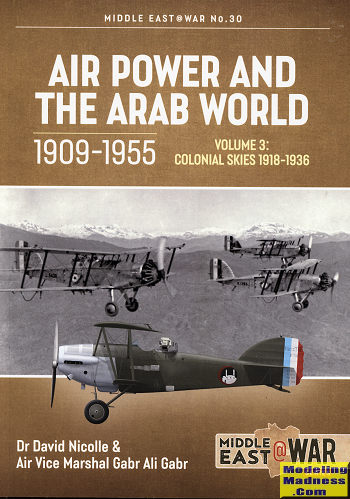 This is the
third edition of a short series on Air Power in the Arab World. For the purposes
of this book that also includes a lot of tribes in the general
Middle East/North Africa region. The time covered by this book is roughly after
WWI and before the start of WWII.
This is the
third edition of a short series on Air Power in the Arab World. For the purposes
of this book that also includes a lot of tribes in the general
Middle East/North Africa region. The time covered by this book is roughly after
WWI and before the start of WWII.
Much of the region in question was controlled more or
less by European powers. Specifically, the Spanish, French, Italians, and
British. During this time period, there were few actual Arab air forces, with
the majority of the military air power being with the colonial powers. Probably
the main reason for this was that this was a time when nationalism was just
starting to take hold and the idea of being people of a nation rather than a
tribe was still a strange notion to many.
We start on in the west of North Africa with Spanish
Morocco and similar Spanish territories. Like most of the western colonial
powers, there were stirrings of trouble from the people who lived there who did
not like being controlled by outsiders. Naturally, the fighting spilled over
into the French part of Morocco as well as into Algeria and Tunisia, though not
to the same extent. France had considered Algeria to be the same as metropolitan
France until the 50s when it was pretty obvious they were no longer wanted. But
that is another story.
The same situation occurred in Libya with the Italians
who at one point, were pushed into small coastal enclaves. In all cases, an
increase in air power was the tipping point that allowed the various nations to
at least control the situation and deal with the 'insurrectionists' involved.
During the early periods, ex-WWI types were put into use, but they were designed
for Europ and not the African desert and proved to be difficult to keep in
service. Eventually, all got fairly new aircraft that were far more useful.
These were mostly reconnaissance types with the ability to carry ordnance, a
type of multi-purpose aircraft that was extremely popular in the colonies of all
European nations.
The British were a slightly different case. Their main
bastion in the area was Egypt where the population already recognized themselves
as a nation. However, Egyptians were treated as second-class citizens in their
own country by the British, who had a firm grip on the military power or the
nation. Even though a small Egyptian Air Force was established, it did not have
modern offensive equipment. The British also had to keep peace in Palestine, in
Aden (Yemen) and in Iraq. Again, there was a lot of dislike of the British and
there was low level trouble all during the 1920s and 30s. As in Egypt, the
British helped to establish a small Air Force in Iraq.
In Persia (Iran), things were a bit different. The
Persians had been playing the field by obtaining aircraft from France and the
Soviets as well as the British. The Persians developed their own air arm and did
all they could to keep the influence of foreign powers to an absolute minimum.
Another place that developed their own air arm was Abyssinia (Ethiopia). Here a
small, but very well trained air force was built up using fairly modern
equipment. The 1935 invasion by Italy put a stop to all that as they were simply
overwhelmed by numbers.
As with the previous volumes, the prose is both
authoritative and easy to read. The authors have really done a fine job going
through various archives to bring us the story. Add to it some superb period
photos as well as full color profiles and you have an excellent addition to this
series. It is a book that I enjoyed reading and I know you will as well. If you
don't learn from this one you aren't trying!
February 2021
Copyright ModelingMadness.com. All rights reserved.
Review book courtesy of
Casemate Publishing, where you can order your copy
at this
link.
If you would like your product reviewed fairly and
fairly quickly, please
contact
the editor or see other details in the
Note to
Contributors.
 This is the
third edition of a short series on Air Power in the Arab World. For the purposes
of this book that also includes a lot of tribes in the general
Middle East/North Africa region. The time covered by this book is roughly after
WWI and before the start of WWII.
This is the
third edition of a short series on Air Power in the Arab World. For the purposes
of this book that also includes a lot of tribes in the general
Middle East/North Africa region. The time covered by this book is roughly after
WWI and before the start of WWII.